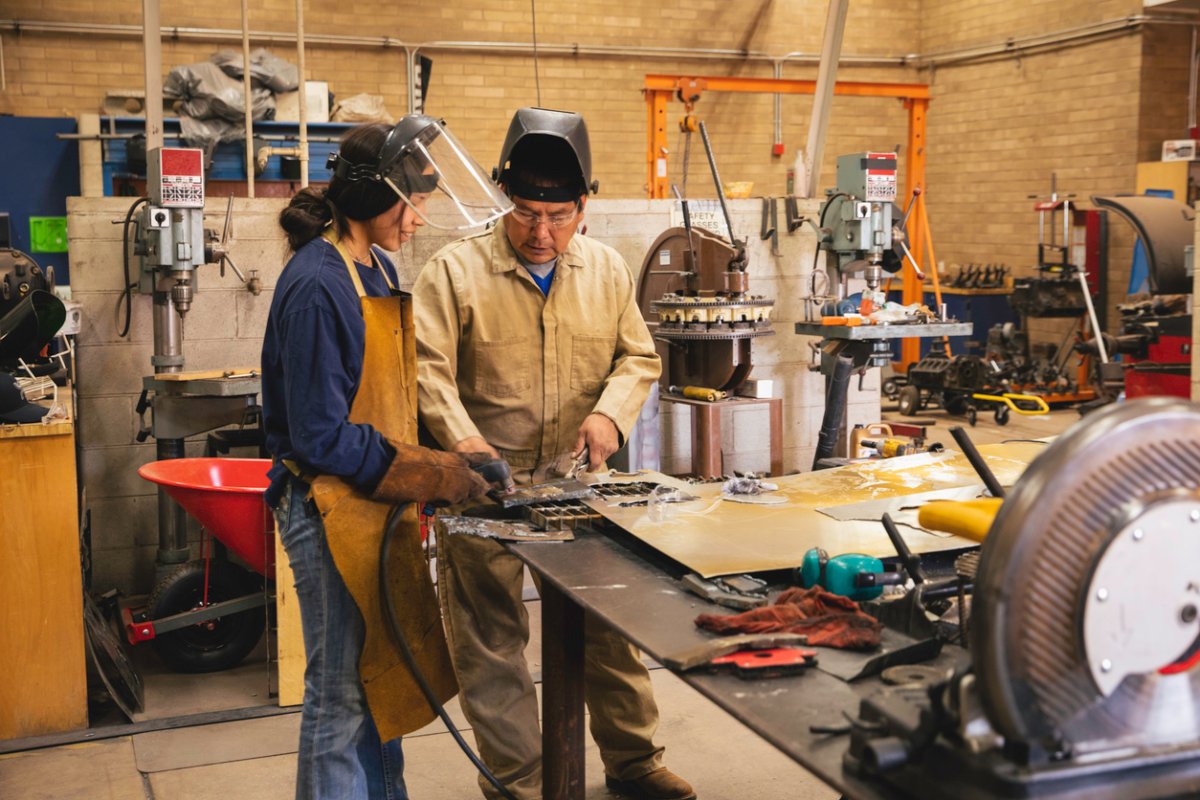

We may earn revenue from the products available on this page and participate in affiliate programs. Learn More ›
Welding is a skilled trade with high demand and the potential for a rewarding career. A welder specializes in joining materials, typically metals or thermoplastics, using high heat to create a strong and permanent bond between the pieces. Welders play an important role in many industries, including construction, manufacturing, and shipbuilding, and can perform various types of repairs. Their work is essential for building and repairing bridges, ships, cars, and countless other products.
Aspiring welders will want to make sure they fully understand the process of becoming a certified welder and starting a career in welding. This includes getting welder training (either at a vocational school or online), gaining welding experience, and learning the specific requirements for welding certification. Once an aspiring welder has completed these steps, this guide can help get them started in the process of becoming a welder.
Before You Begin…
Welding is a physically demanding profession that requires stamina, hand-eye coordination, and the ability to work in uncomfortable positions for extended periods. Those with respiratory conditions or sensitivities to fumes may not be suited for this career path. Because long hours are spent enduring heat, sparks, and fumes, would-be welders need to have a tolerance for working in potentially harsh conditions.
Typically, aspiring welders are required to have a high school diploma or GED. Those who don’t have either will need to complete that educational requirement before taking any additional steps. Welders will also need to have the proper protective clothing, such as the best welding jackets, helmets, and gloves, as well as one of the best welders suited for their experience level.

STEP 1: Take welding courses at a community college or vocational school to learn the trade.
Community colleges and vocational schools offer comprehensive welding programs that provide students with the knowledge and practical experience that’s needed in the field. These programs typically range from 6 months to 2 years, depending on the program’s intensity and the specific welding certifications. While some vocational welder schools offer accelerated programs, community colleges often provide a broader welding education. Students will want to consider their learning styles and career goals when choosing a program.
- In-depth training. Students receive hands-on training on welding techniques, including shielded metal arc welding (SMAW), gas metal arc welding (GMAW), tungsten inert gas (TIG) welding, the differences between MIG vs. TIG welding, and the different types of welds and when to use them. The curriculum will also cover essential safety protocols, proper equipment operation, and blueprint reading.
- Industry-standard practices. Instructors at community colleges and vocational schools are experienced professionals who make sure their students are learning and practicing techniques that go along with industry standards. This ensures the students’ skills are relevant and highly sought after by employers.
- Certification preparation. Many programs integrate exam preparation into their curriculum, giving students a head start on getting their certification in welding.
For those who want to know how to weld their own items or weld for fun, attending a vocational school or community college may not be the best choice. There are plenty of tutorials for beginners to learn the basic steps of welding for DIYers while using the best welders for beginners.

STEP 2: Get practical welding experience through an internship or entry-level position.
Classroom training provides a solid foundation, but real-world experience is essential for success as a welder. Internships and entry-level positions offer valuable opportunities to bridge the gap between theory and practice. By building relationships with instructors and those they meet during internships, students can use these connections as a valuable source of job leads and mentorships as they begin their welding career paths. Additionally, many industries require on-the-job training or apprenticeships that can last from 3 to 5 years
Many welding programs partner with local companies to provide supervised on-the-job training. These internships allow students to work alongside experienced welders while getting exposure to various welding techniques. Students can look through career center resources provided by their school or contact potential employers directly to ask about internship placements.
Entry-level positions often involve assisting experienced welders with tasks like equipment setup, material preparation, and weld cleaning. While the initial focus might be on support, these positions provide a way for novices to learn from seasoned professionals. As students gain experience and demonstrate their skills, they can have opportunities to progress toward more complex welding projects.

STEP 3: Become certified through the American Welding Society (AWS).
Becoming a certified welder through the American Welding Society (AWS) significantly enhances a welder’s employability. AWS certification shows potential employers that a welder possesses the necessary skills and knowledge to meet industry standards.
The AWS offers a variety of certifications catering to different welding processes and skill levels. To earn a certification, a welder will typically need to pass a practical exam that showcases their ability to weld according to specific codes and procedures. Some employers may have specific AWS certifications as requirements for certain welding positions.
Welders will want to research the types of welding certifications offered by the AWS and identify one that goes with the welding techniques they want to specialize in. Many welding schools and training programs offer exam preparation resources to help students familiarize themselves with the testing format and practice their skills.
The welding industry is constantly changing, so staying up to date on the latest techniques and welding qualifications is important. The AWS offers ongoing education and recertification programs to help welders maintain their skills and keep their certifications current. Online resources can supplement hands-on training for aspiring welders. For experienced welders, the best online welding courses can also provide continuing education so they can remain current on the latest welding techniques.
STEP 4: Check to see if there are any welding license requirements in your state.
While most welding companies in the United States don’t require a potential employee to be a licensed welder, there might be exceptions depending on the location and the specific project. By understanding state-specific licensing requirements, welders can make sure they’re legally qualified for the welding jobs they’re interested in.
The best way for a welder to determine whether a state requires a welding license is to check with the state’s licensing board or regulatory agency. These agencies will have the most up-to-date information about licensing requirements or permits that apply to welders in the area. Welders will also want to research requirements for specific types of work. Certain welding projects, especially those involving public safety, might have additional licensing requirements. Finally, welders will want to inquire with potential employers in their area about any licensing requirements they might have for their welding positions.
While there’s typically no national license required, many employers look to hire certified welders.

STEP 5: Look for a job in the welding industry.
Once a welder has developed their skills and acquired the certifications to launch their career, they can begin searching for a job. The welding industry offers a variety of options, so it’s important for welders to take the time to consider their interests and what work environment would be the best for them. Welders who want to start their own business will need to research how to get a business license to begin their own venture.
When looking for a welding job, applicants can use online job boards that list welding positions and welding requirements across various industries. They can search for keywords related to their specific welding skills and certifications to find the best opportunities. Welders will want to consider construction, manufacturing, repair, or even niche sectors such as aerospace or underwater welding.
Another avenue for finding a job is through the welder’s professional network. Connections made during internships and training programs can be used to find a job. Welders will want to reach out to their network to inquire about job leads on open positions, or to ask for a written referral for potential employers.
Finally, staffing agencies specializing in skilled trades can be a great resource for finding welding jobs. These agencies often have strong relationships with companies looking for qualified welders.
STEP 6: Consider learning specialized welding skills to expand your welding job horizons.
While a strong foundation in core welding skills is important, welders will want to consider expanding their skill set by learning specialized welding techniques. This can significantly enhance their employability and open doors to unexpected career paths in the welding industry.
Certain industries, like aerospace, pipeline construction, or underwater welding, require specialized skills and certifications. By acquiring these skills, welders can position themselves to work in a niche market with potentially higher-paying jobs and greater job security. Learning specialized welding techniques like TIG welding for thin materials or orbital welding for automation can make welders more versatile and valuable to potential employers. Embracing continuous learning by acquiring new skills shows a welder’s dedication to the field and their commitment to staying ahead of the curve.
Becoming a certified welder is a career path filled with challenges and rewards. By following several steps, aspiring welders can gain the knowledge, hands-on experience, and certifications needed to find a welding job that lines up with their interests and qualifications. The welding industry offers a variety of opportunities, so welders will want to explore specialized welding techniques to further expand their skill set and career options. With dedication and a commitment to continuous learning, a welder can have a successful and long-lasting career.
